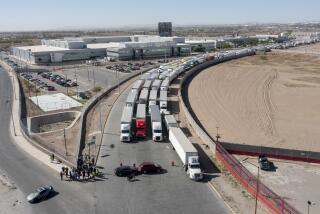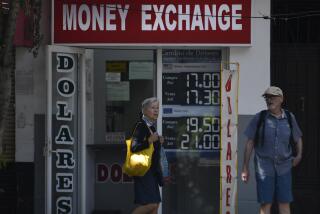Peso Nears Two-Year High Against Dollar
MEXICO CITY — Spurred by a stable economy and high interest rates, Mexico’s peso is near a two-year high against the dollar, meaning that Californians headed south of the border for summer vacations should pack more cash along with sunscreen.
The currency ended trading Thursday at 10.66 to the greenback, a 4.6% increase on the year, putting it among the world’s strongest currencies against the dollar in 2005. At the peso’s low point, in May 2004, it took 11.67 pesos to buy a dollar.
International investors have been attracted by Mexico’s interest rates of more than 9%, snapping up peso-denominated debt that many see as a bargain given Mexico’s solid growth and low risk compared with other developing nations. That strong demand has boosted the currency’s value against the dollar.
Mexico’s economy, projected to grow at a rate of 3.5% this year, also is giving the currency some momentum. Billions of dollars’ worth of remittances sent home by migrants working in the U.S. also have helped bolster the peso, analysts said.
The currency’s rise has been a boon for Mexican consumers, for whom U.S. goods have become cheaper, fueling a shopping spree along some parts of the southern U.S. border. Retail sales in McAllen, Texas, which is heavily dependent on visitors from the Mexican cities of Reynosa and Monterrey, are up 6% through April, compared with the first four months of 2004, according to the McAllen Chamber of Commerce.
“When you go to the mall, it’s like Christmas every weekend. You can’t find a parking space,” said Steve Ahlenius, president of the business group.
Equity investors also are profiting. Mexico’s IPC stock index closed Thursday at its third consecutive record high, up 79.83 points, or 0.6%, to 14,085.06. The index is up 9% year to date. But the gain for U.S. investors in dollar terms is even larger -- 14% -- because of the peso’s strength.
Less thrilled are Mexico’s export-oriented manufacturers, which are already struggling to compete with China. A rising peso makes Mexican goods more expensive in the United States, the destination for about 90% of Mexico’s exports.
Although Mexico’s shipments north of the border continue to increase, China has surpassed it to become the second-largest supplier, behind Canada, of goods imported by the U.S. Trade statistics released this week showed that through the first five months of the year, Mexico’s exports to the U.S. grew 8.7% while China’s surged 27.9%. Critics have accused China of keeping its currency artificially low to give its products an edge on world markets.
Ernesto Moguel, a partner in Tlaxcala, Mexico-based Ermo Industrial, which manufactures cotton trousers, said a strengthening peso was squeezing his business because he accepted dollars in payment from U.S. customers whereas most of his expenses were in pesos. The net effect is less profit in his pocket.
“It’s not helping us,” he said of the rising peso.
U.S. visitors to Mexico are also getting less bang for their bucks. But so far, the dollar’s slide against the peso is having no visible effect on tourism. Mexico’s Tourism Ministry said this month that a record 9.35 million foreigners visited the country in the first five months of the year. That’s a 10.2% increase over the same period in 2004. The vast majority of those visitors are from the U.S.
Vacationers paying more for that margarita can blame it on Mexico’s central bank. Ever wary of inflation that has wreaked havoc on the nation’s economy in the past, the Bank of Mexico raised interest rates a dozen times between February 2004 and March 2005. Mexico’s overnight lending rate stands at 9.75%, compared with the U.S. Federal Reserve’s benchmark rate of 3.25%.
“Mexican interest rates are still quite high,” said Suhas Ketkar, a Latin American economist at RBS Greenwich Capital Markets.
He doesn’t believe it will last, however. Mexico’s inflation is running at about 4.3% on an annualized basis, a respectable showing. Ketkar said he expected the central bank to start easing monetary policy in the fall, which could put the peso back over 11 per dollar by year-end.
The big question is what could happen next year as Mexico readies for its July presidential elections. Election years have often been volatile for Mexico’s financial markets.
“That is sort of a wild card risk to the currency,” Ketkar said.
Times staff writer Tom Petruno in Los Angeles contributed to this report.
More to Read
Inside the business of entertainment
The Wide Shot brings you news, analysis and insights on everything from streaming wars to production — and what it all means for the future.
You may occasionally receive promotional content from the Los Angeles Times.










